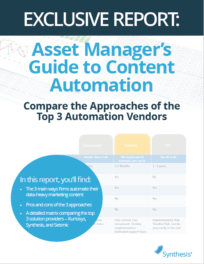3 keys to improving your quarter-end process

I recently completed an RFP that posed this question:
“Describe the factsheet production cycle and timeline for your most efficient client and your least efficient client.”
This got me thinking: What really drives efficiency in marketing document production? Over the past 25 years, I have seen just about every variation on technology and process models that can exist to support factsheet production. I’ve seen firms that have embraced technology and process to improve their efficiency ten-fold. On the flipside, I’ve seen firms that seem to do everything in their power to undermine the efficiency of a technology or process they’ve paid good money for.
When advising our clients and prospects, here are three things we always recommend to dramatically improve the efficiency of their quarter-end process:
#1 Organize your team
Over the years, I have found that the highest performing and most effective marketing teams share this in common: A strong marketing team with clear ownership of the process and product. A team that operates with a mandate and authority is more likely to get documents out the door twice as fast as one without those factors.
Our most efficient client produces over 1,500 documents in fewer than 10 business days because they made it a priority to organize their team.
They are able to collect all of their data, cleanse and approve it, deliver it to their communication systems, and publish their marketing materials — all within 2 weeks. From a time-to-market perspective, this is a remarkable achievement.
No surprise, these guys have strong leadership. The CMO made it very clear that getting documents out the door is a mission critical activity. The 2.5 person team has the ability to push, pull and prod to get the materials they need. Their whole literature strategy has been designed to emphasize time-to-market through optimal sharing and reuse of materials, content, approvals, etc. Their vendor and each person involved in the process knows exactly what is expected each day and all parties are held accountable for meeting their timelines.
Let’s contrast this military precision with the slowest organizations I’ve seen at work.
The common threads there are rooted in either some level of operational apathy about the documents, or a misguided effort to make the process a multi-department collaboration. Or maybe both. I watched one client struggle to achieve efficiency largely because they delegated the work between a variety of people from different departments including product management, fund accounting, marketing, compliance and communication services (i.e. the design team) with no clear owner of the process.
Academically speaking, the workflow that was planned and implemented to support this strategy was a work of art, but in practice not even the best technology on the market could fix their problems. Documents would sit in the queue for days with no progress because the work just wasn’t important enough to this far flung collection of people. And there was no strong head of marketing who was empowered to herd the cats to the finish line.
Organizing and empowering your team with clear responsibilities, goals and authority is absolutely essential.
#2 Clean-up your data management process
Traditionally one of the biggest pain-points for marketing teams is organizing their data. Firms that haven’t found ways to fundamentally solve their source data problems will experience built-in delays.
I’ve seen a disorganized data management process set a team back as many as 10 days. Meaning while other clients were finishing, these guys were just getting started.
We’ve heard things like, “Nobody wants to own the data”, or “We wait and wait for the data and when it finally arrives, it’s crazy.” From workflow issues to data errors and inconsistencies, it is quite a feat to tame the data beast.
 Few firms really manage their data effectively on their own.
Few firms really manage their data effectively on their own.
While many firms have one or more internal data warehouses that are supposed to serve the needs of marketing, these are really operations focused and not equipped to support marketing and public reporting functions. Marketing’s needs are unique and evolving. Home grown data repositories never seem to quite “get” this point.
In most cases, the firms that are handling their data most efficiently use a commercial solution. A data management solution that is built specifically for this purpose brings order to the workflow, provides clear ownership and accountability for data files, and effectively cleans the data to make it readily available for marketing.
The old phrase holds true: garbage in, garbage out. The clean data challenge is one that fund marketers will continue to face until they can find ways to get a handle on their data.
#3 Get your marketing team out of the trenches
In 16 years of deploying our document automation technology, I can honestly say that no marketing staffer has lost their job due to it’s implementation. The whole point of automation is to free-up your team to do more value-added work.
Solutions like ours allow teams to reallocate their resources to do more strategy and planning activities instead of keying-in numbers, proofreading documents and playing with font sizes.
You should be looking into automation if your organization is producing more than a handful of recurring documents and/or if you have even a half of a staff member devoted to updating documents manually.
When set up properly, automation solutions produce materials with outstanding aesthetics, accuracy, and consistency. Most importantly there is a real auditable process which mitigates the compliance risks associated with human error and ad-hoc processes.
Small firms can also benefit from automation. When a firm is staged for growth and begins experiencing a scaling problem, that’s when we usually get the call for help.
For example, we’ve done implementations for three clients recently with as few as 14 products to market.
By embracing automation and process management early, all three of these firms have been able to ramp up both their product growth and literature plans with very few growing pains.
Ideally, automation planning should begin prior to a firm reaching this scaling problem.
Investing in automation technology is a key factor in any aggressive growth plan because it takes your marketing talent out of the trenches to focus on more strategic work.
Conclusion
Overall, an automation partner can be truly valuable to your firm and a worthwhile investment from many standpoints. The benefit of audit trails, expert advice, and secure data warehousing can insulate your firm from compliance issues.
The bottom line is this: You are marketing in an information-driven industry and your competitors are refining their process and pushing out documents and web updates faster than ever. If you’re not working on the speed and accuracy of your marketing collateral, you’re at a disadvantage. The firm that gets their information out the fastest, with the most accuracy, wins the race.









 Compare the Top 3 Finserv Content Automation Vendors [White paper]
Compare the Top 3 Finserv Content Automation Vendors [White paper] Create Pitchbooks the Drive Sales [White paper]
Create Pitchbooks the Drive Sales [White paper] Build vs. Buy: Should Your Financial Services Firm Outsource or Insource Marketing Technology? [White paper]
Build vs. Buy: Should Your Financial Services Firm Outsource or Insource Marketing Technology? [White paper]  10 Tips for Rebranding your Fund Marketing Documents [White paper]
10 Tips for Rebranding your Fund Marketing Documents [White paper]



